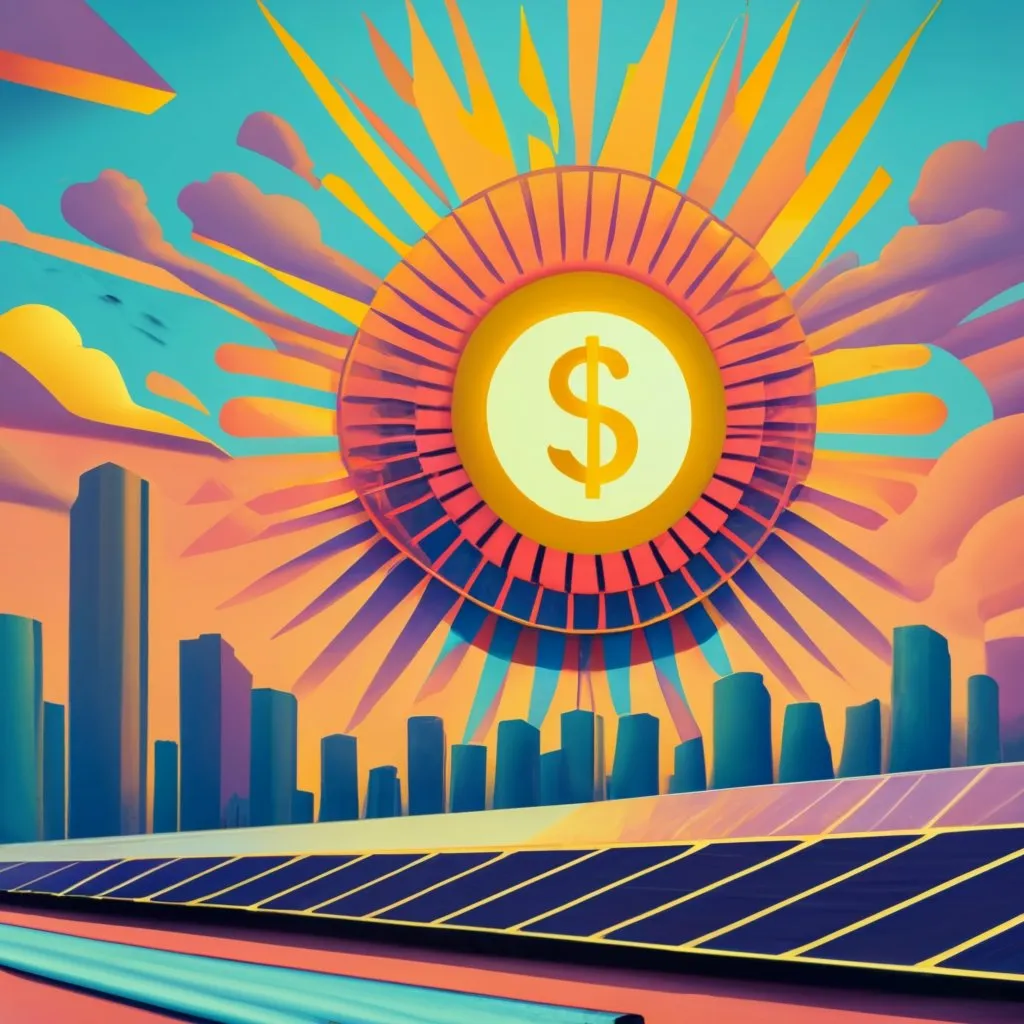Introduction
In a world where the urgency for sustainable solutions has never been more evident, solar energy is emerging as one of the most promising alternatives to alleviate our dependence on fossil fuels. In addition to being a renewable and clean energy source, the infinite potential of the sun represents hope for a greener and healthier future. However, the adoption of this technology goes beyond its efficiency and ability to generate energy sustainably, introducing a variable that is often underestimated: aesthetics.
Aesthetics play a crucial role in how we perceive, accept and adopt new technologies and innovations. In the context of solar energy, the design and appearance of solar panels, as well as their integration into the urban and rural landscape, can significantly influence the acceptance and dissemination of this form of energy. After all, while functionality is essential, visual appeal is also a determining factor in the consumer's decision.
The goal of this article is to explore how design and aesthetics can not only coexist with functionality and efficiency, but also enhance the impact and adoption of solar energy. We will investigate how harmonizing aesthetic design with solar technology can serve as a catalyst for public acceptance, and how this can shape and influence the trajectory of our sustainable future.
As you browse this article, we invite you to reflect on the possibilities that unfold when we align technological innovation with aesthetic appeal, and how this synergy could be the key to unlocking a sustainable future powered by sunlight.
Current Solar Energy Panorama
Growth and Development of Solar Energy
The solar energy sector is experiencing exponential growth globally. Driven by technological advances, cost reductions and a growing awareness of the need for renewable energy sources, solar energy is consolidating itself as a viable and increasingly affordable alternative. Countries around the world are investing significantly in infrastructure and research, aiming to expand solar power generation capacity and harness the sun's untapped potential.
Challenges Facing Solar Energy
Despite significant progress, the solar energy journey still faces obstacles. Issues such as intermittency in energy generation, the need for efficient storage systems and the occupation of large areas for the installation of solar parks are persistent challenges. Furthermore, public acceptance and harmonious integration of solar installations in urban and rural environments remain points of discussion and improvement.
The aesthetics of solar panels, sometimes perceived as intrusive or disharmonious, can represent an impediment to the large-scale adoption of this technology. Property owners, urban managers and the general population seek solutions that, in addition to being efficient, are visually pleasing and complement the existing landscape.
The Importance of Innovation and Design in the Solar Industry
In this scenario, innovation and design take on a leading role in the solar industry. The search for more integrated and aesthetically pleasing designs is a crucial step towards overcoming resistance and accelerating the adoption of solar energy. Companies and researchers are exploring new materials, formats and integration techniques, aiming to create solutions that combine energy efficiency with an attractive design.
The introduction of aesthetic innovations not only has the potential to transform public perception of solar energy, but also to open up new markets and opportunities. Sustainable architectural projects, integrating solar energy in a harmonious and creative way, are gaining prominence and demonstrate that it is possible to reconcile beauty and sustainability.
As we move further along the solar energy trajectory, the balance between technological innovation and aesthetic appeal will be increasingly vital. This promising balance could be the catalyst for a future where solar energy not only powers our homes and cities, but also enriches our environment and visual experience, contributing to a sustainable and aesthetically inspiring future.
The Importance of Aesthetics in Solar Energy
How Aesthetics Affect Consumer Acceptance
Aesthetics are a key element in the acceptance and adoption of solar energy. The first impression of a product or technology often determines a consumer's willingness to adopt it, and solar energy is no exception. While efficiency and sustainability are critical factors, the visual appeal of solar panels and harmony with the surroundings significantly influence consumer decisions. An attractive, integrated design can transform solar energy from an alternative option to a preferred choice, driving acceptance in homes, businesses and public spaces.
Examples of Aesthetically Pleasing Solar Projects
Several projects around the world exemplify how solar energy can be aesthetically pleasing and functional. A notable example is SolarLeaf in Hamburg, Germany, where building facades are equipped with biophotonic solar panels that also grow microalgae, resulting in a vibrant look and sustainable energy production. Another example is the Cestas Solar Park in France, designed to harmoniously integrate into the natural landscape, minimizing visual impact while generating renewable energy.
These projects demonstrate that solar energy can be incorporated in creative and attractive ways, contributing to public acceptance and inspiring the implementation of innovative solar solutions in different contexts.
The Role of Architecture and Design in the Development of Solar Solutions
Architecture and design are essential fields in the development of aesthetically pleasing solar solutions. Architects and designers have the ability to shape the way solar energy is perceived by inventively integrating it into buildings and public spaces. They are responsible for creating solutions that not only meet energy needs, but also enrich the community's visual and cultural experience.
Through interdisciplinary collaboration between designers, architects, engineers and other professionals, it is possible to develop projects that combine functionality and beauty, increasing the value of solar energy and encouraging its large-scale adoption. By prioritizing aesthetics, we can overcome barriers, alter perceptions and pave the way to a future where solar energy is a valued and welcomed presence in our built environments.
Education and Awareness
Education plays a central role in promoting solar energy, acting as a bridge between scientific knowledge and the practical application of this renewable resource. By cultivating an in-depth understanding of the importance and benefits of solar energy, we create the foundations for a society that is more informed, conscious and committed to sustainability.
The Importance of Education in Promoting Solar Energy
Education is the key to unlocking the transformative potential of solar energy. Through the dissemination of information, training of professionals and engagement of communities, education fosters a culture of environmental responsibility and encourages the adoption of sustainable practices. Furthermore, it demystifies erroneous concepts, expands understanding of the benefits of solar energy and inspires innovation and creativity in the search for clean energy solutions.
Strategies to Raise Awareness about Solar Aesthetics
Awareness about solar aesthetics is essential to harmoniously integrate solar technology into our daily lives and urban environment. Strategies such as workshops, exhibitions of innovative solar projects and social media campaigns can highlight the beauty and functionality of solar energy, attracting more followers. Additionally, including solar aesthetics in academic curricula and training programs can cultivate a deeper appreciation for sustainable design and foster the next generation of solar designers and architects.
How Education Can Contribute to the Acceptance and Appreciation of Solar Aesthetics
Education has the power to shape perceptions and values. By integrating solar aesthetics into environmental education and related disciplines, we promote an appreciation of the harmony between technology and nature. Continued exposure to sustainable design concepts and practical examples of successful implementation can positively influence the acceptance of solar energy. Furthermore, education empowers individuals with the knowledge necessary to make informed decisions and value solutions that combine efficiency, beauty and sustainability.
Ultimately, education and awareness are powerful tools for building a more sustainable and aesthetically inspiring future. They plant the seeds of change, inspire creativity and encourage the continuous search for innovation and harmony between man and the environment. Through education, we can envision a future where solar energy is not just a source of electricity, but also a source of inspiration and beauty for all.
Success Stories
Projects that Combine Aesthetics and Sustainability
Several global projects exemplify the successful union between aesthetics and sustainability, showing that it is fully possible to balance visual beauty and energy efficiency. One of the most iconic examples is the Louvre Abu Dhabi Museum, which utilizes innovative architectural design to maximize the use of sunlight while maintaining a visually striking aesthetic.
Another notable case is the Solar Tree in Nevers, France, an artistic and functional installation that combines street lighting with electric vehicle charging, showing how solar energy can be creatively integrated into urban spaces.
Analysis of the Impact of these Projects on the Community and the Environment
The impact of these projects goes beyond the production of clean energy. They serve as icons of innovation and sustainability, encouraging public acceptance of solar energy and inspiring the adoption of green solutions. The Louvre Abu Dhabi Museum, for example, not only reduces energy consumption, but also acts as an educational and cultural point, raising awareness among visitors about the importance of sustainability.
The Solar Tree in Nevers, in turn, in addition to being an urban landmark, promotes sustainable mobility and generates awareness about the aesthetic possibilities of solar energy, challenging traditional perceptions about how solar technology can be incorporated into everyday life.
Lessons Learned and Points for Improvement
These success stories offer valuable lessons about integrating aesthetics and sustainability. They demonstrate that innovative design can facilitate the acceptance of solar technology and that visual beauty can coexist with energy efficiency. However, they also highlight the need for continued innovation and research to overcome technical and aesthetic challenges and expand the possibilities for integrating solar energy in different contexts.
Furthermore, they highlight the importance of collaboration between different sectors – such as art, architecture, engineering and urban planning – to create holistic solutions that meet environmental, social and aesthetic needs. Reflection on these projects also suggests that, to accelerate the transition to a sustainable future, it is critical that we continue to explore and value the aesthetic potential of solar energy.
The Future of Solar Aesthetics
Trends in Solar Design and Technology
As we move into the era of sustainability, several trends in solar design and technology are beginning to come to the fore. The incorporation of solar panels into construction materials, such as tiles and glass, is an innovation that promises to integrate energy generation harmoniously into the aesthetics of buildings. Furthermore, the evolution in solar panel designs, with thinner, more flexible and colorful options, allows for greater customization and adaptation to different architectural styles.
Another significant trend is the development of multifunctional public spaces that integrate solar energy, such as parks and squares equipped with solar structures for charging devices, lighting and even interactive art, creating more sustainable and engaging urban environments.
How Aesthetics Can Contribute to the Mass Adoption of Solar Energy
Aesthetics have the potential to be a significant catalyst for the mass adoption of solar energy. An attractive, integrated design can transform public perception, making solar solutions seen not only as sustainable alternatives, but also as aesthetic improvements for homes, businesses and public spaces.
The ability to harmonize solar technology with architecture and urban design can reduce resistance and broaden interest in solar energy, promoting its adoption in a variety of contexts and scales. By combining beauty, functionality and sustainability, it is possible to create an emotional connection and value solar energy even more in the eyes of the public.
The Role of Designers and Architects in Shaping a Sustainable Future
Designers and architects have a unique responsibility and opportunity in shaping a sustainable future through solar aesthetics. They are the agents of change who can redefine how society perceives and interacts with solar technology, creating innovative solutions that integrate renewable energy generation creatively and harmoniously into the urban fabric.
By adopting interdisciplinary approaches and exploring the aesthetic possibilities of solar energy, designers and architects can inspire acceptance, stimulate the public imagination and contribute to building a future where sustainability and beauty go hand in hand. They have the power to transform solar energy into an artistic and functional expression that enriches our environment, promotes well-being and drives the transition to a greener and more harmonious world.
Social and Environmental Implications
Environmental Benefits of Solar Energy
Solar energy is one of the cleanest and most sustainable energy sources available, playing a crucial role in reducing dependence on fossil fuels and mitigating climate change. By harnessing sunlight to generate electricity, we contribute to reducing greenhouse gas emissions, reducing air and water pollution and conserving natural resources. Furthermore, solar energy, being renewable and abundant, offers a long-term solution to the world's growing energy demand, helping to preserve biodiversity and promote public health.
How Aesthetic Design Can Influence Public Perception and Behavior
Aesthetic design has significant power to shape public perception and influence behavior. Incorporating solar solutions in an artistic and harmonious way into buildings and urban spaces can transform the image of solar energy, making it perceived not only as eco-efficient, but also as an aesthetic and cultural improvement. This, in turn, can increase acceptance and interest in solar technology, encouraging large-scale adoption and fostering a more sustainable mindset among citizens.
Innovative, aesthetically pleasing design can serve as a catalyst for conversations about sustainability, educating the public about the importance of eco-friendly practices and inspiring individual and collective action for the environment.
The Influence of Solar Aesthetics in Creating Sustainable Communities
Solar aesthetics have the potential to play a key role in creating more sustainable communities. By integrating solar solutions in a creative and visually appealing way into architecture and urban design, it is possible to create environments that reflect ecological values and promote well-being.
Communities that embrace solar aesthetics become models of innovation and sustainability, encouraging others to follow suit. Furthermore, the harmonious integration of solar energy can strengthen the sense of belonging and community identity, fostering cooperation and environmental responsibility among inhabitants.
The influence of solar aesthetics goes beyond the visual; it has the power to connect people, value the culture of sustainability and inspire a positive transformation in the way we live and interact with our planet.
Conclusion
Summary of Main Points Discussed
Throughout this article, we explore the intersection between aesthetics and sustainability in the context of solar energy. We discuss the growth and challenges of the solar industry, highlighting how innovations in design have the potential to influence the acceptance and adoption of this form of energy. We analyze success stories that combine beauty and efficiency, demonstrating the positive impact that well-designed projects can have on the community and the environment. Additionally, we reflect on trends in solar design and technology, the crucial role of designers and architects, and how solar aesthetics can influence the creation of sustainable communities and public perception.
Reflection on the Potential of Aesthetics in Promoting a Sustainable Future with Solar Energy
Aesthetics are more than a mere superficial consideration; it has the power to shape our environment, influence behavior and inspire change. Solar aesthetics, in particular, could be the key to unlocking a more sustainable future, where renewable energy is valued not only for its functionality, but also for its ability to enrich our experiential and cultural space. By exploring the aesthetic potential of solar energy, we have the opportunity to redefine the relationship between technology and society, promoting a harmonious integration that benefits both the planet and future generations.
Call to Action: How Society Can Contribute to This Future
Each of us has a role to play in building a sustainable future powered by solar aesthetics. Consumers can express their preferences and demand innovative and aesthetically pleasing solar solutions. Designers and architects have the responsibility and opportunity to lead by example, creating projects that combine form and function in a sustainable way. Governments and companies can invest in research and development, fostering innovation and encouraging the adoption of solar energy.
Together, we can reimagine the future of solar energy, enhancing its beauty, exploring its potential and contributing to a more sustainable and harmonious world. The journey to a sustainable future with solar energy is collective, and every step, every choice and every innovation counts. Let us all be protagonists of this transformation.
References
- International Energy Agency (IEA). Publications and reports on renewable energy and solar energy. Available in: IEA Website
- World Energy Council. Reports and publications on global energy issues, including solar energy. Available in: World Energy Council Website
- Solar Energy Industries Association (SEIA). Reports and statistics on the US solar energy market. Available in: SEIA Website
- National Renewable Energy Laboratory (NREL). Publications and research on solar energy and other forms of renewable energy. Available in: NREL Website
- European Solar Energy Association (EPIA). Publications and statistics on the development of solar energy in Europe. Available in: SolarPower Europe Website
- United Nations Environment Program (UNEP). Publications and reports on sustainability and renewable energy. Available in: UNEP Website
- Zumthor, P. (2006). Thinking Architecture. Basel: Birkhäuser.
- Pallasmaa, J. (2012). The Eyes of the Skin: Architecture and the Senses. Chichester: John Wiley & Sons.
- Scientific Journals: For technical information and case studies, consider consulting scientific journals such as Solar Energy Journal, Renewable Energy, It is Sustainable Energy Technologies and Assessments.
- Green Building Councils. Information and guidelines on sustainable constructions. Available in: World Green Building Council Website
- World Wildlife Fund (WWF). Publications and reports on sustainability and environmental impact. Available in: WWF Website
These sources can offer a solid foundation of knowledge for those who wish to further explore the aesthetic potential of solar energy and its role in a sustainable future.




